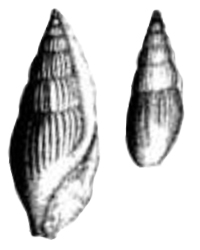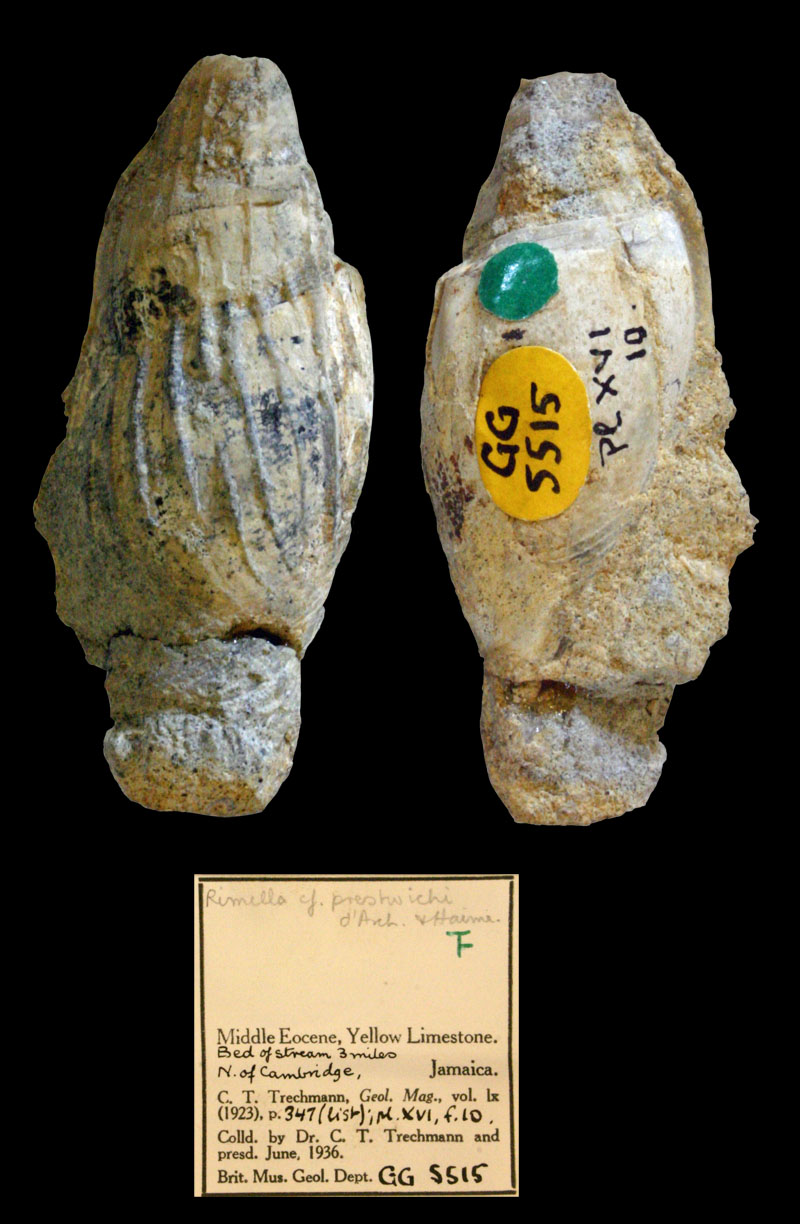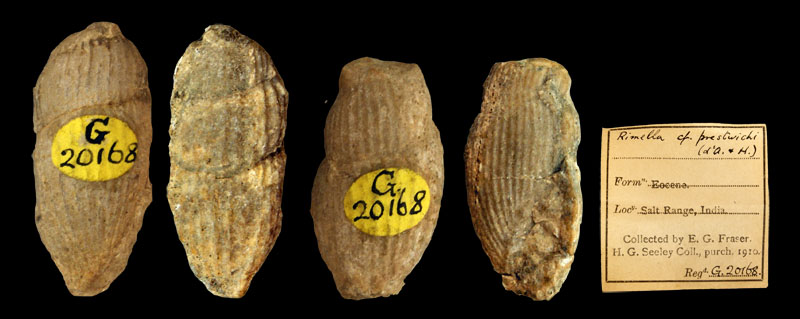|
edit SideBar
|
Species / Rimella Prestwichi
Stromboidea
Original Description of Rostellaria prestwichi by d'Archiac & Haime, 1854, p. 312:
- "Coquille fusiforme, composée d'environ 8 tours, légèrement convexes, séparés par une suture simple et couverts de côtes longitudinales nombreuses, étroites, très-rapprchées, lisses comme les sillons qui les séparent. Quelques bourrelets s'observent ca et là. Les côtes s'atténuent vers la base du dernier tours ou elles sont traversées par des stries fines, régulières et équidistantes, jusqu'à la callosité du bord gauche. Les caractères de l'ouverture sont encore inconnus; mais on voit que ses bords remontaient le long de la spire, sous forme de lames soudées l'une a l'autre, et se recourbaient probablement en arrière, avantd'atteindre le sommet. Hauteur des plus grands individus, 26 millim. environ; diamétre du dernier tour, 9."
Locus typicus: "Calcaire jaune de la chaine d'Hala", Sinde, Inde
Description of Rostellaria prestwichi var. a minor (fig. 8):
- "Coquille plus petite, déprimée et proprtionnement plus allongée, surtout à sa base."
Rostellaria Prestwichi d'Archiac & Haime, 1854, pl. XXX, fig. 7, 8
Comment by d'Archiac & Haime, 1854, p. 313:
- "Observations. Nous avons en quelque sorte reconstruit cette espèce avec les nombreux fragments que nous possédions, et les caractères qu'elle nous a montrés suffisent pour la regarder comme nouvelle. Elle diffère, en effet, du R. fissurella, Lam., si commun dans le calcaire grossier du bassin de la Seine, par ses tours plus hauts, plus aplatis, sa forme générale plus turriculée, ses plis beaucoup plus nombreux, plus serrés, plus droits, et les sillons qui les séparent plus étroits, plus profonds et toujours lisses. Les mêmes différences, jointes au système de stries transverses qui orne le R. crassilabrum Desh. (loc. cit., pl. LXXXIV, fig. 2-4), le R. rimosa, J. Sow. (Miner. conchol. pl. XCI, fig. 4-6), et le R. decussata, Gratel. (Conchil. foss., pl XXXIII, fig. 3), ne permettent pas non plus de le confondre avec eux. Notre espèce est aussi parfaitement distincte du Rostellaire de la province de Cutch que M.J. de C. Sowerby rapporte au R. rimosa (Transact. geol. Soc. of London, 2e sér., vol. V, pl XXVI, fig. 17), et qui offre en effet des stries comme la coquille de l'argile de Barton. Nous partageons d'ailleurs l'opinion de M.J. de C. Sowerby, contrairement à celle de M. Deshayes (Coq. foss., vol. II, p. 622), et de M. Nyst (loc. cit., p. 557), ces deux derniers auteurs réunissant les R. fissurella et rimosa. Ce serait seulement, suivant nous, le R. lucida, Sow., qui pourrait être regardé comme l'analogue de l'espèce des environs de Paris."
History and Synonymy
1875
Mallada, 1875 reported Rostellaria prestwichi from "Raya de Castellazo, Bernués; Sierra de Guara; Roda."(p. 214), Spain
1909
Description by Cossmann, M. & Pissarro, G. 1909:
- “Size moderate, shape slender, fusiform; spire elongated, conical or slightly conoidal, consisting of seven whorls whose height equals seven-tenth of their width, feebly convex, separated by deep sutures, ornamented with thin, constricted, rather crowded, oblique, axial ribs, regularly distributed throughout the whorls, interspersed with a few thick irregular varices. Body-whorl large, including more than half the total height, with an oblique varix on the ventral region, oval at its base which is excavated only behind the neck, and upon which the gradually disappear and are replaced by spiral grooves revolving round the neck. Aperture fusiform, narrow, with the posterior angle chocked by the columellar callosity and the prolongation of the outer lip, anteriorly ending in an acute rostrum bent towards the left; outer lip thin, rather sinuous, posteriorly produced into a broad expansion which extends up to the apex of the spire which it completely conceals, and then crosses over the opposite side which it follows nearly to the penultimate whorl; columella smooth approximately rectilinear, oblique; columellar margin very callous, rather narrow, with a distinct boundary, on the base, but extending also on to the ventral surface as a thin layer which spreads up to the varix, and completely masks the axial ribs.”
Comments by Cossmann and Pissarro, p. 47:
- “Although this shell is very closely related to the common eocene species of Europe, R. fissurella, Lamk., yet it is distinguished by a whole series of differential characters: the axial ribs are much finer and much more numerous; the aperture is narrower and taller; the depression adjacent to the rostrum is not so deeply notched; the prolongation, upon the spire, of the outer and inner lips, constitutes a more prominent raised lamella, and extends further down to the opposite side of spire. The rostrum is broken in all adult specimens which we have examined, but it is preserved on some of the younger ones, when it appears sharp and less deflected to the left than in R. fissurella. Even on the most perfectly preserved individuals, it is impossible to detect any revolving striae between the axial ribs, while in R. fissurella, these intervals are delicately striated; the only spiral ornaments of R. Prestwichi are the basal striations of the body-whorl. The axial ribs are continued upon the wing with a slight increase of width of their spacing; on the posterior region of this aliform margin, they are replaced by oblique folds, representing the successive lines of adjustment between the wing and the spire before commencing its phase of senile development after which it envelopes the apex, and advances upon the opposite side. Lastly the groove which, from the posterior angle of the aperture, very distinctly separates the callosity of the outer lip from that of the inner one, is continued all along the crest of the wing which it divides into two adjacent lamellae even beyond the summit. None of the above characters exist in R. fissurella. Compared with R. duplicosta, Cossm., from the eocene of Egypt, or with R. inaequicostata, Boettg., from the eocene of Borneo, the Indian species is distinguished by the equal distribution of the ribs all along the spire, while in the two other species, the spacing becomes about double on the last whorl. Of the two figures of this species published by d’Archiac and Haime, only one (fig. 7), represents a fairly well preserved individual, very similar indeed to those that we have figured, only with the aperture less complete than in our plesiotype.”
Specimens from institutional collections
Rimella cf. prestwichi (d'Archiac & Haime, 1854); Yellow Limestone, middle Eocene; Bed of stream, 3 miles north of Cambridge, Jamaica Island, Caribbean; Coll. BM(NH) no. GG5515; Copyright BM(NH)
Rimella cf. prestwichi (d'Archiac & Haime, 1854); Eocene; Salt Range, Pendjab Province, Pakistan (ex India); 25 mm and 21 mm; Coll. BM(NH) no. G.201068; Copyright BM(NH)
References
- d'Archiac, A., Haime Jules, 1854; Description des animaux fossiles du groupe nummulitique de l'Inde, précédée d'un resumé géologique et d'une monographie des Nummulites. Gide & Baudry, Paris, Vol. 2, pp. 223, pls. 15
- Cossmann, Pissarro & Vredenburg, 1909
- L. Mallada, 1875 .Breve Resena Geolica de la Provincia de Huesca. Catalogo de la Especies Fosiles encontradas en el Grupo Numulitico de la Provincia de Huesca. Anales de la Sociedad Española de Historia Natural., Vol. 4, p. 169-232. Link
|



